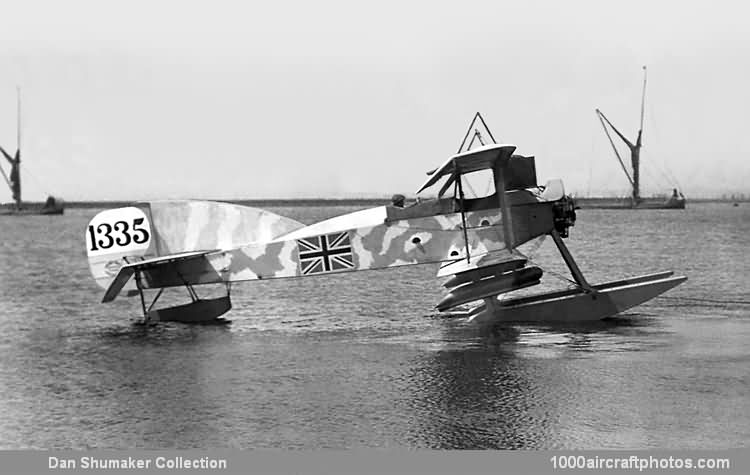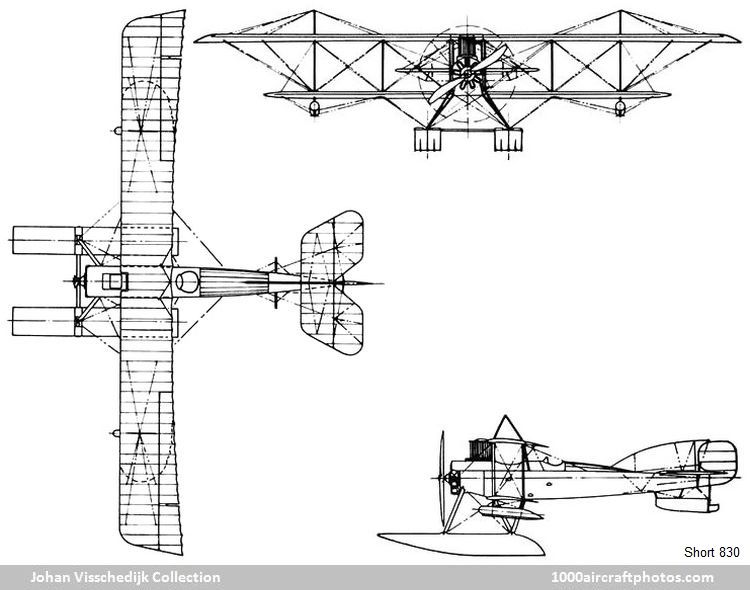The first examples of these engines, roughly equivalent in power and weight to the Salmson nine- and fourteen-cylinder liquid-cooled radials (which were being purchased in small numbers from France), were not ready by the outbreak of war. In anticipation of deliveries, however, the Admiralty had during the early summer of 1914 ordered twelve new reconnaissance bomber seaplanes from Short Brothers, Rochester, Kent, similar in most respects to the Type 166. It had a provision to mount one Lewis gun on rear cockpit, and a bomb load of two 112 lb (51 kg) or four 65 lb (29 kg) could be carried on underwing racks.
Six of these single-engine, two-seat, two-bay, twin-float biplanes, referred to as Admiralty Type 830 (s/n 819 to 821 and 828 to 830, c/n S.108 to S.110 and S.117 to S.119), were powered by the 135 hp Salmson liquid-cooled radial engine, while the balance, referred to as Admiralty Type 827 (s/n 822 to 827, c/n S.111 to S.116), featured the 150 hp Sunbeam Nubian.
By the time these seaplanes were being completed at the end of 1914, the Admiralty was beginning to express a preference for bombs, and neither the Type 827 nor 830 had provision to carry torpedoes. Moreover, despite its slightly inferior performance, it was the Type 827, with its indigenous Sunbeam engine, that was selected for the greater production.
Sub-contracts were placed with The Brush Electrical Engineering Co. Ltd., Loughborough (s/n 3321 to 3332 and 8230 to 8237), The Fairey Aviation Co. Ltd., Hayes, Middlesex (s/n 8550 to 8561, c/n F.4 to F.15), Parnall & Sons Ltd., Eastville, Bristol (s/n 8218 to 8229 and 8250 to 8257) and The Sunbeam Motor Car Co. Ltd., Wolverhampton (s/n 8630 to 8649) for a total of 72 aircraft. In addition to twelve Type 830s (s/n 1335 to 1346, c/n S.131 to S.142), thirty further Type 827s were ordered from Short (s/n 3093 to 3112 and 3063 to 3072, c/n S.143 to S.172), which switched production from Eastchurch to Rochester.
Following shipboard trials by s/n 824 and 826 with HMS Campania in June 1915, Type 827s began delivery to the RNAS Stations at Calshot, Dundee, Grain, Great Yarmouth and Killingholme, being equipped to carry a pair of 112 lb bombs for coastal patrol duties. When Lowestoft and Southwold were shelled by warships of the German High Seas Fleet in April 1916, a Short 827 was among the British seaplanes which attacked the enemy ships with bombs.
Three Short 827s were shipped to East Africa to spot for British naval guns operating against the German warship Konigsberg trapped in the Rufiji delta, but arrived too late to take part; they were therefore sent on to Mesopotamia where two of them, converted as landplanes with wheel landing gears, flew bombing attacks on the Turkish forces advancing on Kut in December 1915.
Another epic involved the use of four Short 827s, s/n 3093 to 3095 and 8219, which were handed over to Belgian volunteers who, in March 1916, were opposing German colonial forces on Lake Tanganyika. Dismantled and transported overland to Lake Tongwe, they were assembled and flown in May, and two months later bombed the German lake cruiser Graf von Goetzen in port at Kigoma, leading to the surrender of the town three days later.
In the UK, Short 827s remained in service until late in 1918."

